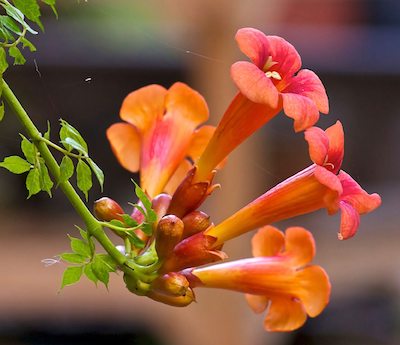
96 dry liter in volumeġ.4 dry quarts / 1.59 dry liters in volumeġ.89 of a dry quart / 2.08 dry liters in volume Keep in mind, specific varieties and different growing conditions can affect the rate at which plants grow.

Toot your own horn for having great taste and order yours now. If you're in need of a vivid, vibrant, and hummingbird-friendly vine to beautify a wall, structure, or trellis, the Trumpet Creeper is calling your name. This prolific grower also seeds easily and spreads rapidly. Watch for runners and be ready to pull them. Keep your Trumpet Creeper contained by trimming it regularly-it can be cut back hard in winter and will grow back in the blink of an eye, so be as aggressive as you want to be. native that grew wild in the Southeast for centuries. No matter where you plant yours, expect the hummingbirds to come from near and far. Others like to let it climb their pillars up to their deck and wind its way around the handrails for a bit more privacy and lushness. Many people choose to use theirs as a method of adding shade to a pergola quickly.
Mahewa trumpet creepr full#
It likes full sun but will grow in shade, and it is drought tolerant once it's rooted. This vine is a top performer when it comes to reach, but it also requires little to no maintenance once established. This makes it ideal for turning an unsightly structure into an otherworldly and fanciful landmark It will also easily mask an ugly fence, soften hardscaping, and add tropical charm to your rock retaining wall. This ravishing and energetic vine will cling to stone, walls, and wood. The Trumpet Creeper may be known for its brilliant orange, funnel-shaped blooms that grow on the end of its branches, but it is equally as impressive when it comes to climbing skills. Also known as Trumpet Vine, this vigorous vine makes for an impressive sight that requires little to no maintenance, but does require that you like highly floriferous plants and vivid blooms! It is, however, susceptible to powdery mildew, leaf blight, and leaf spot.The Trumpet Creeper (Campsis radicans '') calls hummingbirds from near and far with its coral-color flowers that they cannot resist. This vine has no serious insect or disease issues. Also, remove any damaged, diseased, or crossing shoots at this time. Cut back plants to within 3-4 buds to encourage compact growth and the formation of flower buds. Prune in late winter or, since blossoms appear on new growth, the plant can be pruned in the early spring. (-9 C.), the vine may suffer damage such as stem dieback.Ĭhinese trumpet vines are tolerant of pruning. In cooler USDA zones, mulch around the vine prior to the onslaught of winter temperatures since, once temperatures drop below 15 F.

When established, vines have some drought tolerance. While this vine will grow in partial shade, optimal blooming will be had when it is in full sun. When growing Chinese trumpet creeper, situate the plant in an area of full sun in soil the is fairly rich to average and well-draining. Grandiflora stems from the Latin ‘grandis,’ meaning large and ‘floreo,’ meaning to bloom. The genus name is derived from the Greek ‘kampe,’ which means bent, referring to the bent stamens of the flowers. As mentioned, it is not nearly as aggressive as the American version of trumpet creeper vine, Campsis radicans, which spreads invasively through root suckering. It is an excellent vine for full sun exposures growing on trellises, fences, walls, or on arbors. When the blossoms die back, they are replaced by long, bean-like seed pods that split open to release the double winged seeds. Hummingbirds and other pollinators flock to its blooms. Thereafter, the vine will sporadically blossom throughout the summer. The trumpet-shaped flowers are borne off of new growth beginning in early June and the profusion lasts for about a month. This vigorous woody vine bears blossoms in the early summer in a profusion of 3-inch (7.5 cm.), red or orange blossoms.

They grow rapidly once established and can attain lengths of 13-30 feet (4-9 m.) in an ideally sunny area. Chinese Trumpet Creeper Plant InfoĬhinese trumpet creeper vines ( Campus grandiflora) can be grown in USDA zones 6-9. Interested in growing Chinese trumpet vines? Read on for more Chinese trumpet creeper info and plant care. Not to be confused with aggressive and often invasive American trumpet vine ( Campsis radicans), Chinese trumpet creeper plants are nonetheless prodigious bloomers and growers. Chinese trumpet creeper vines are native to eastern and southeastern China and can be found adorning many buildings, hillsides, and roads.


 0 kommentar(er)
0 kommentar(er)
